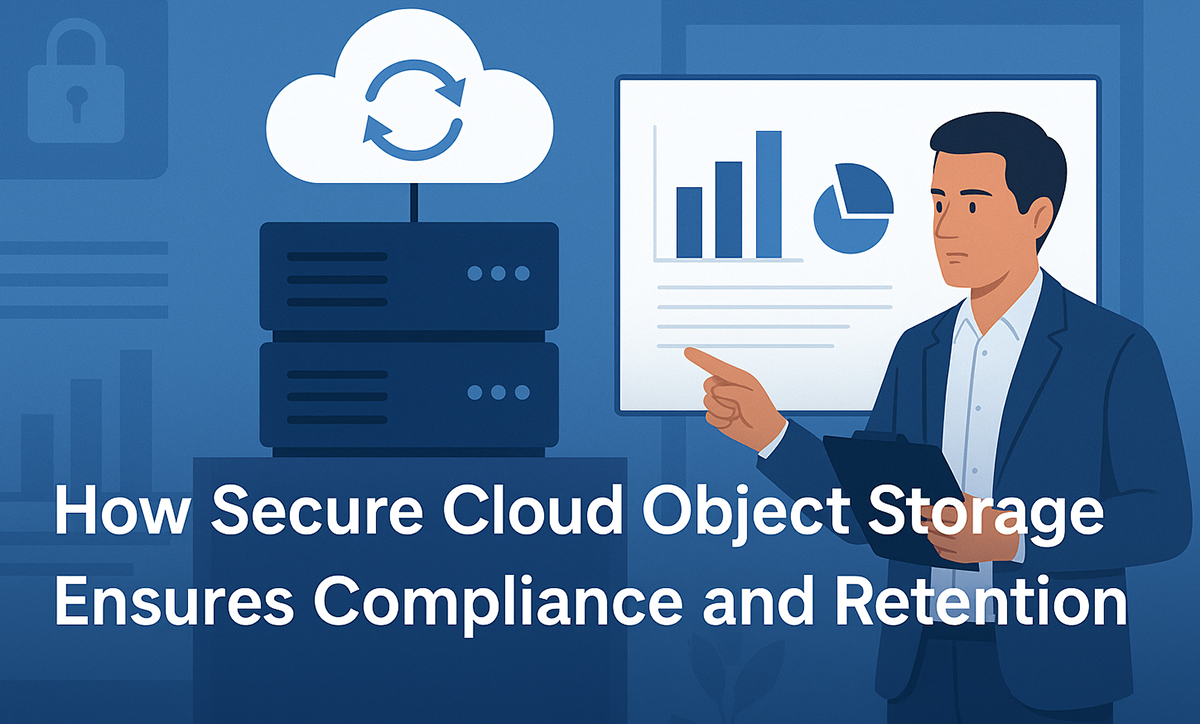No products in the cart.
 The Need for a Smarter Storage Approach
The Need for a Smarter Storage Approach
As data volumes grow and compliance rules tighten, traditional storage systems like tapes and on-prem solutions fall short. They’re costly, complex, and risky. In contrast, cloud object storage offers a modern solution-secure, scalable, and built for long-term retention in a compliance-driven world.
What Is Cloud Object Storage?
Unlike file or block storage, object storage handles data as individual units-each with its own metadata and ID. This architecture removes hierarchy, making storage massively scalable and easy to manage. Metadata adds retention rules, version control, and access settings-making it ideal for archiving, compliance, and governance.
Why Long-Term Data Retention Matters
Data regulations like HIPAA, GDPR, and SOX require organizations to store records for years, sometimes indefinitely. Beyond compliance, historical data holds strategic value-fueling analytics, machine learning, and audit-readiness. Cloud object storage ensures this data stays protected and available over time.
Security That Goes Beyond Storage
Cloud object storage is designed for robust security:
- Encryption protects data in transit and at rest.
- Immutability (via object lock and WORM policies) prevents unauthorized alterations.
- Access controls like RBAC and multifactor authentication ensure only the right people access sensitive archives.
- Redundancy across regions and automatic integrity checks boost resilience.
Meeting Regulatory Standards with Confidence
Cloud providers offer tools to support industry regulations. Audit logs, legal holds, and geographic data controls support adherence to key regulatory standards including HIPAA, GDPR, and FINRA. Such features facilitate easier compliance verification and strengthen the transparency of audit processes.
Choosing the Right Storage Tier for Your Data
Cloud storage isn’t one-size-fits-all. Providers offer tiers based on access frequency:
- Hot storage: For frequently accessed files
- Cool/infrequent access: For data accessed occasionally
- Archive/deep archive: For long-term data rarely retrieved
Automated lifecycle rules shift data between tiers, helping balance cost with accessibility.
Immutability: Your Final Line of Defense
Immutable storage ensures backup integrity by locking data against changes for a set period. WORM and object lock features help defend against threats like ransomware or accidental deletion making immutable storage essential for reliable long-term retention.
Smart Lifecycle and Retention Management
Cloud-native tools enable automated retention strategies. You can define how long data is retained, when it’s moved between tiers, and when it’s safely deleted. Lifecycle management keeps your storage clean, efficient, and compliant-without manual intervention.
Top Cloud Providers and Their Offerings
- AWS S3: Offers Object Lock, intelligent tiering, and comprehensive tool integrations
- Azure Blob Storage: Delivers immutable blob storage and legal hold capabilities to safeguard data from modification or deletion.
- Google Cloud Storage: Demonstrates robust performance in data security, lifecycle policy enforcement, and advanced AI integration.
- Wasabi: Known for flat-rate pricing and built-in immutability
Each has its own strengths depending on your business needs and budget.
Cost Optimization Without Compromising Security
Storage can become expensive if unmanaged. Use tiering and lifecycle rules to keep active data accessible and archive the rest. Compression, deduplication, and regular reviews help cut unnecessary costs while keeping your data secure and compliant.
Implementation Best Practices
- Classify data: Know what needs to be stored, and for how long.
- Automate: Use cloud-native tools and third-party platforms to enforce policy.
- Review regularly: Adapt your retention policies as laws and business needs evolve.
- Test recovery: Ensure that what’s stored can actually be restored when needed.
Avoiding Common Mistakes
- Misconfigured retention settings can lead to unintended deletions.
- Egress fees can surprise you when retrieving archived data.
- Ignoring compliance nuances like residency or retention gaps can expose you to penalties.
Regular audits and a clear understanding of cloud policies help you avoid these pitfalls.
Real-World Examples of Long-Term Storage in Action
- Healthcare: Storing patient records and medical imaging securely for years
- Finance: Archiving transaction logs and compliance records
- Media: Preserving high-resolution video and creative assets for future use
These industries rely on cloud object storage for secure, reliable, long-term access to critical data.
What’s Next: AI and ML for Smarter Retention
Artificial intelligence is reshaping data retention. Tools now assist with auto-classifying data, predicting optimal storage tiers, and spotting anomalies in access patterns. This tech reduces manual tasks and keeps your storage strategy proactive.
Secure cloud object storage is no longer optional-it’s essential. It provides the scale, security, and compliance support organizations need to store their most valuable data for the long haul. By choosing the right provider, setting smart policies, and leveraging built-in tools, businesses can turn long-term retention from a challenge into a competitive advantage.Stay updated! Follow us on social media! Facebook, Twitter, LinkedIn
Check out our newest blog entry (Website Launch Checklist for a Seamless Go-Live)
Subscribe to get free blog content to your Inbox



 The Need for a Smarter Storage Approach
The Need for a Smarter Storage Approach